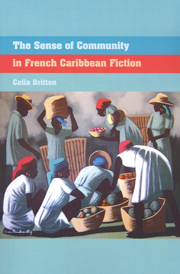Book contents
- Frontmatter
- Contents
- Acknowledgements
- Abbreviations
- Introduction
- 1 Restoring Lost Unity in Jacques Roumain's Gouverneurs de la rosée
- 2 Past, Future and the Maroon Community in Edouard Glissant's Le Quatrième Siècle
- 3 Living by Mistake: Individual and Community in Simone Schwarz-Bart's Pluie et vent sur Télumée Miracle
- 4 Singular Beings and Political Disorganization in Vincent Placoly's L'Eau-de-mort guildive
- 5 Conquering the Town: Stories and Myth in Patrick Chamoiseau's Texaco
- 6 Community, Nature and Solitude in Daniel Maximin's L'Ile et une nuit
- 7 On Not Belonging: Surrogate Families and Marginalized Communities in Maryse Condé's Desirada
- Conclusion
- Notes
- Bibliography
- Index
4 - Singular Beings and Political Disorganization in Vincent Placoly's L'Eau-de-mort guildive
- Frontmatter
- Contents
- Acknowledgements
- Abbreviations
- Introduction
- 1 Restoring Lost Unity in Jacques Roumain's Gouverneurs de la rosée
- 2 Past, Future and the Maroon Community in Edouard Glissant's Le Quatrième Siècle
- 3 Living by Mistake: Individual and Community in Simone Schwarz-Bart's Pluie et vent sur Télumée Miracle
- 4 Singular Beings and Political Disorganization in Vincent Placoly's L'Eau-de-mort guildive
- 5 Conquering the Town: Stories and Myth in Patrick Chamoiseau's Texaco
- 6 Community, Nature and Solitude in Daniel Maximin's L'Ile et une nuit
- 7 On Not Belonging: Surrogate Families and Marginalized Communities in Maryse Condé's Desirada
- Conclusion
- Notes
- Bibliography
- Index
Summary
Unlike Roumain, Glissant and Schwarz-Bart, who all appear regularly on francophone literature courses in Europe and North America, Vincent Placoly is almost unknown outside the French Caribbean. He died while still in his forties, in 1992, having written three novels, a number of shorter literary pieces, and a large amount of political journalism. L'Eau-de-mort guildive, his second novel, came out in 1973 when he was twenty-seven. Placoly was a student in Paris between 1963 and 1969; he was introduced to Maurice Nadeau, who encouraged him in his writing and published his first two novels in the ‘Lettres nouvelles’ series at Denoël. They have affinities with some of the other, much better-known, writers whom Nadeau published and/or wrote on: Malcolm Lowry, Blanchot, Raymond Queneau and the Nouveau Roman in particular. But L'Eau-de-mort guildive is also an extremely original work, characterized by a surreal atmosphere and a chaotic structure. There is no continous narrative: the novel's sixteen short chapters relate a number of unconnected or very loosely connected events involving an open-ended group of characters who appear and disappear more or less at random, and whose conversations make up the greater part of the text.
The novel's cryptic title is an indication of the kind of language that characterizes the novel. ‘Guildive’, unknown in standard French, is the local name for a cheap rum that was originally produced for the slaves: an ‘eau-de-vie’ that here is rather associated with death.
- Type
- Chapter
- Information
- The Sense of Community in French Caribbean Fiction , pp. 74 - 92Publisher: Liverpool University PressPrint publication year: 2010



